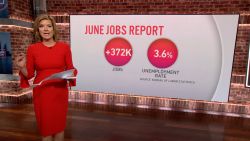Sometimes, there are warning signs that you are in danger of being laid off – a buyout of your company, a merger or a strategic change in direction. Other times, the cuts come without warning. But while being laid off is not in your control, being financially prepared for such an event is.
“Companies evolve, change and fail and employees, and even business owners, need to be prepared for the unexpected,” said Mike Silane, a chartered financial analyst with 21 West Wealth Management.
Save up some extra cash
Building up savings in a reserve fund is job number one.
The amount depends on your field and level of seniority, said Mike Zung, a financial planner at Java Wealth. For in-demand positions with plenty of openings or lower level jobs, having three months of expenses covered should suffice, he said.
“If you are very specialized and earn a high salary, you are at greater risk of being unemployed or underemployed for a longer period,” Zung said. “Your emergency fund may need to be able to cover six- to nine-months of expenses.”
Make sure your reserve fund is separate from your checking account, said Cory Nichols, a financial coach at Yes Life Financial.
“Not only are you more likely to dip into it if it’s at the same bank, but you probably aren’t even keeping up with inflation,” he said. He recommended using a high-interest savings account that is not connected to your primary bank, but is still accessible.
Check your expenses
In order to know how much savings you need, check your expenses and figure out how much you really need to get through a month.
“Just because you can currently afford a higher mortgage or car payment, doesn’t mean you would be able to if you were laid off,” said Joseph Brady, a financial planner with Rock Financial Planning, but you won’t know unless you track what is coming in and going out.
In addition to paying down credit card debt, he suggested moving to an all cash payment plan for a bit.
“Pull out cash to pay for everything so you don’t get accustomed to just charging everything,” said Brady. “While this may seem difficult at first if you’re not used to it, it helps you to understand your true spending.”
This is also a good time to cull the lifestyle extras you aren’t using and don’t need.
“If you think you might get laid off, go through your budget and see what expenses you could cut,” said Scott Newhouse, a certified financial planner with Forthright Finances. “Do you need all those subscriptions? Do you need to eat out as much? Do you need to be paying that much for cable? If you can, find some savings now that would help you get through any job loss.”
Refinance while you still can
If you feel your name could be on a shortlist for cuts at work, consider refinancing your mortgage. Restarting with a 30-year mortgage will lower your monthly payments, said Robert Falcon, a certified financial planner at Falcon Wealth Managers.
“Sure, it will break your heart to go back to a 30-year mortgage if you have like seven years left on your current mortgage,” he said. “But the chance to lower your burn rate is too good to pass up. And if you don’t get laid off, you can always make the same payments you were before to wrap up that mortgage in seven years.”
Falcon also recommended taking out a home equity line of credit, or HELOC, while you are employed.
“That is a nice thing to have in your back pocket,” he said.
But most HELOCs have a variable interest rate that will start creeping up, so it might not be the best source of emergency cash if you hang onto it too long. “You’ll need a more permanent solution – it is just a bridge to help with cash flow.”
Use your benefits
With changes on the horizon, now is the time to use, or in many cases, lose your employee benefits.
While a health spending account (HSA) can travel with you from job to job, a flexible spending account (FSA) is owned by the employer. If you don’t incur the expenses and use your FSA, the money stays with the company that just let you go.
Schedule the colonoscopy, get the Lasik surgery or pick up some extra supplies at the drugstore, said Falcon.
Check in with your 401(k), too.
“If you’re flush with cash, you can accelerate your 401(k) contributions to get to the max for the year early,” he said.
This is also the time to pay back any money you may have borrowed as a loan from your 401(k), said Falcon.
Skills are something you can take with you when you go, so make use of educational opportunities at your current job.
“Many employers have budgets that employees may use to gain new skills, licenses, or even college degrees,” said Jonathan Bird, a certified financial planner and head of Farnam Financial.
Get properly insured
Having a life insurance policy that’s separate from the one offered by your employer, as well as your own disability insurance, can protect you from a sudden loss of income or health issue.
Generally, an employer’s group life insurance policy ends when you leave your job and you’ll need to apply for new coverage. This usually isn’t a big deal, but some health conditions can make it hard for some people to find an affordable policy.
To determine how much life insurance you need, Nichols uses this rule of thumb: Take your monthly take-home pay times two, and add two zeros. If you have $4,000 a month in income, you need $800,000 in life insurance.
“It’s one less thing you have to worry about if you ever lose your job,” Nichols said.
























